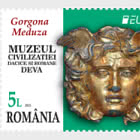Romfilatelia, the company specialized in issuing and trading Romanian postage stamps, is releasing the philatelic issue entitled Viticulture.
“The ancient homeland of the “Geto-Dacians”, Thracia, was a winegrowing region and it was considered to be the birth place of Dionysus, the god of wine”, according to the great historian A. D. Xenopol. Viticulture is one of the oldest trades in the Danube-Carpathian-Black Sea space, which is attested not only by the first written records, but by historians such as the Greek Strabon, the German A. Griesbach or the French Raymond Billiard.
As it is well known, at the beginning of the 1st century B.C., viticulture had reached such amplitude simultaneous to the organization of the first centralized and independent Dacian state, that the king Burebista initiated certain activities in order to restrict the culture of the vines. However, viticulture and wine production went on, a fact which was revealed by the Roman poet Ovid and by other narrative and artistic sources as well.
The most eloquent pieces of evidence regarding the spreading of the viticulture in the Dacian era are the following Dacian origin words, as proof of continuity: strugure (grape), butuc (grape vine), curpen (clematis), words which are particular to the winegrowing activities. The development of viticulture went on during the Roman occupation as well, a fact which is attested by the medal “Dacia Felix”, issued by the Romans, which bore the emblem of two children holding a wheat ear and a grape, sign of the main riches to be found in the country.
The development of viticulture in our country was favoured by the climate, the soil characteristics and especially by the solar radiation in the areas particularly know as podgorii (vineyards). In the rural area, the wine cellars built at the surface or the one built in the basements (wine vaults) had the purpose of storing the viticultural tools, the harvested products, also serving as space for the production of wines characteristic to each vineyard. The winegrowing civilization influenced certaind traditions and customs particular to the Romanians.
Furthermore, the Romania Christian tradition bestows a scared signifance upon wine and vines. The wine stands for “the sacrifice of the Lord, representing His blood” and the vines for “our spiritual life dedicated to Christ, revealed with His help”.
On the background of the stamps there are details from the sculpture of the Stavropoleos Church iconoclast from Bucharest, built in 1724. The philatelic issue consists of a block of four postage stamps having the same face value of ROL 21,000 and RON 2.10, illustrating some of the most important varieties of vines grown in Romania, such as: the variety Grasa de Cotnari, the variety Feteasca alba, the variety Feteasca neagra, the variety Vicoria.











































